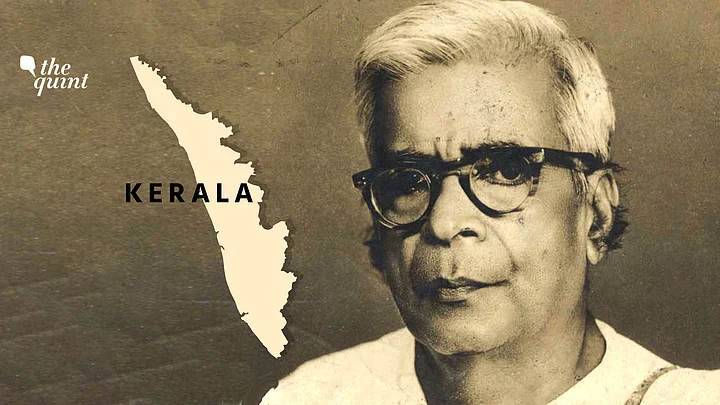Fifty years after his death, the man hailed as “Kerala Gandhi” is a largely forgotten figure. Look up his awards and recognitions, and all you can find for Koyapalli Kelappan (24 August 1889 – 7 October 1971) is that India Post released a commemorative stamp in his honour in 1990. That seems like a scant tribute for such a remarkable figure. The Mathrubhumi, a newspaper he helped establish and of which he served briefly as its Editor, carried my tribute in Malayalam on his death anniversary yesterday; The Quint is a fitting place to remedy that neglect in English.
During our country’s independence movement, you could not speak of the Indian National Congress in Kerala without mentioning K Kelappan. A graduate of the University of Madras, he taught at Ponnani and at St Berchman’s High School, Changanassery, later serving as the principal of Karukachal High School, run by the NSS. It was while studying law in Bombay that he came under the Mahatma’s spell. Beginning his political career with Mahatma Gandhi’s Non-Cooperation movement — to support which he abandoned his law studies and became Secretary of the Congress Party in Ponnani taluk — and adopting the simple, ascetic lifestyle of his hero, Kelappan was soon seen as the foremost Gandhian in South-western India. And it is a social reformer and a Gandhian visionary that he is best remembered as.
A Passionate Opponent of Caste Discrimination
Unlike many political leaders, K Kelappan was a man of action: he put his feet where his principles were. Trained in 'Kalaripayattu' from a very young age, he entered the fray in every satyagraha and agitation. He was frequently arrested and imprisoned by the British for his role in the freedom struggle. But like the Mahatma, he believed that the real struggle for freedom was not only against the British but against social evils in our own society.
A passionate opponent of caste discrimination, and especially untouchability, he worked hard to eradicate it in Kerala, including through personal example. He was among the first in Kerala to drop the surname that advertised his caste status.
His role in the Vaikom Satyagraha movement in 1924 and his leadership of the Guruvayur Satyagraha in 1932 (where his “fast unto death” succeeded in opening the temple to all castes) are trailblazing events in the freedom struggle. When the Mahatma visited Travancore to commemorate the Temple Entry Proclamation, it was Kelappan who resisted challenges to the Mahatma’s authority and seconded K Kumar’s resolution establishing faith in Gandhiji's leadership.
From an MP to a Sarvodaya Worker
The “Kerala Gandhi’s” skills as an organisation-builder were apparent early. He was one of the founders of the Nair Service Society and served as its first president. He also founded the Kerala Kshetra Samrakshana Samiti (Temple Protection Movement) and served in a slew of Gandhian organisations, including the Kerala Sarvodaya Sangh, the Kerala Gandhi Smarak Nidhi, the Kerala Sarvodaya Mandal and the Gandhi Peace Foundation, Calicut — indeed it is difficult to think of a Gandhian body of any consequence in our state in whose leadership he had not served. He was also the distinguished President of the Kerala Pradesh Congress Committee at the time of Independence, leading the KPCC from 1945 to 1950.
As a politician, independence activist, educationist and journalist, he had few peers in what is today Kerala.
He might easily have become a Minister either in the state or in the national government, but instead, soon after independence had been won, he left the Congress Party in 1951, believing he could serve the people better through Acharya Kripalani’s Kisan Mazdoor Praja Party, of which he was a founding member and under whose banner he was elected to Parliament from the Ponnani Lok Sabha seat in the first-ever General Elections of 1952 (when the KMPP and the Socialist Party merged to form the Praja Socialist Party (PSP), Kelappan led the new party in Kerala). While serving as MP, Kelappan supported and worked for the unification of Kerala into a new linguistic state.
But as a Gandhian reformer, he soon tired of the speech-making in Parliament. After just one term, he left active politics altogether, preferring to serve as a Sarvodaya worker. When Acharya Vinoba Bhave started the Bhoodan Movement to persuade landlords to give land to the landless, Kelappan was the movement’s foremost voice in Kerala. Yet, he was a strong critic of Marxism and of the policies of the EMS Namboodiripad-led Left government. He established the Rural Institute at Thavanoor, which is now part of the Kerala Agriculture University.
A Selfless Leader
Kelappan also spoke out against communalism of every kind, while upholding the rights of all to live in harmony, without encroaching on the legitimate aspirations of each other. He led the 'Thali Temple Movement' to rebuild an ancient temple at Angadippuram in Malappuram, which had been destroyed by Tipu's forces in the 18th century — an effort that had been disapproved of by the state government on the grounds that a mosque now stood nearby — and conducted a successful 'Satyagraha' for the reconstruction of the temple. Today, both places of worship stand side by side in Angadipuram, testimony to the harmonious flourishing of religious co-existence among the two principal communities.
The final measure of the man can be found in a telling detail. When Kelappan breathed his last on 7 October 1971, the selfless leader, who had served in so many important positions for half a century, left a bank balance of ₹28.
We may not see his like again.
(Former UN under-secretary-general, Shashi Tharoor is a Congress MP and an author. He can be reached @ShashiTharoor. This is an opinion piece and the views expressed above are the author’s own. The Quint neither endorses nor is responsible for the same.)
(At The Quint, we question everything. Play an active role in shaping our journalism by becoming a member today.)
